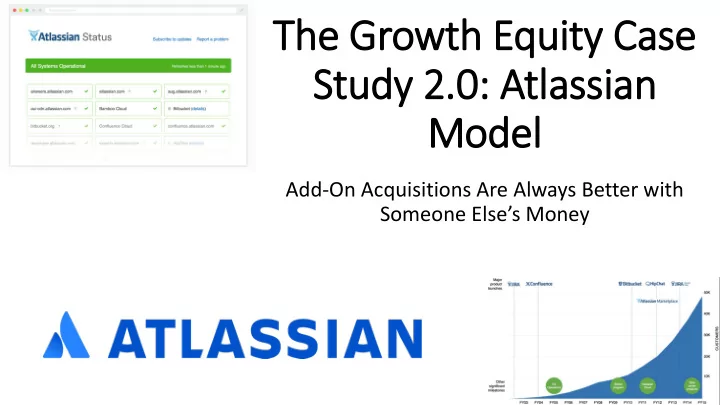

The Growth Equity Case Study 2.0: Atlassian Model Add-On Acquisitions Are Always Better with Someone Else’s Money
What is Growth Equity? This entire tutorial corresponds to an M&I article on the topic: https://www.mergersandinquisitions.com /growth-equity/ We’ll expand on that M&I article here and show you more of the Excel parts.
Pla lan for This Tutorial • Part 1: What is Growth Equity? • Part 2: Highlights of a Growth Equity Case Study and Model • Part 3: How to Make an Investment Recommendation
Part 1: What is Growth Equity? • Basic Idea: Mix of private equity (leveraged buyouts) and venture capital (investing in risky but high-growth-potential startups) • Difference 1: Only tend to invest minority stakes in companies • Difference 2: Companies must have proven markets and business models, i.e., have actual revenue, even if they’re not profitable • Difference 3: Companies use the investment for a specific growth purpose, such as market/geographic expansion, more sales reps, factories, acquisitions, etc.
Part 1: What is Growth Equity? • Other Differences: A few related to the financial characteristics of deals… • Targeted Multiple or IRR: Often 3-5x and 30-40%; lower than the 5-10x that VCs target and higher than the 2-3x PE target • Returns Sources: Primarily growth , whether organic or other, no debt paydown, and maybe some from multiple expansion • Leverage: Minimal debt used, but sometimes they use preferred stock or hybrid securities like convertible bonds to mitigate risk
Part 2: Growth Equity Case Study Highlights • This one comes from our Excel & Fundamentals course and is based on Atlassian , a software company that creates tools for programmers • Financials: < $1 billion in revenue, slightly negative operating income, 40% revenue growth, and transition to subscription model • Question: Should we invest $2 billion for a small stake in Atlassian so they can use the funds to acquire other, high-growth software companies and get customers and cross-selling like that? • NOTE: This is a bit weird since Atlassian is far too big for a traditional growth equity deal, $2 billion is huge, etc., but we’ll go with it
Part 2: Growth Equity Case Study Highlights • Revenue: Billings vs. Revenue → Billings represents cash collected from customers for orders, but isn’t recognized right away • New Customers: Billings increases by XX% per year (50% to 30%) • Existing Customers: Certain percentage renew and accept price increases, so their Billings also increase • Subscription Billings: New Billings + Existing Billings • Revenue: % Recognized from This Year + % Recognized from Prev Year
Part 2: Growth Equity Case Study Highlights • License & Maintenance Revenue is similar, but Licenses are simple one-time sales, and New Maintenance Revenue comes directly from License sales in that year • Expenses: Some are simple percentages of Revenue or Billings; others, like R&D, are based on the Employee Count and Cost per Employee • Next: We use these assumptions and fairly standard ones for Working Capital (e.g., Accounts Receivable as a % of Revenue) to build the financial statement projections
Part 2: Growth Equity Case Study Highlights • Add-On Acquisitions: The company spends $700 – $775 million per year over 5 years to acquire other, high-growth companies • Problem: Company pays an average 20x revenue multiple for them! Yes, they’re high growth(~100%), but are they worth that much? • Setup: We created a mini-waterfall schedule to show the revenue and EBIT from each acquisition each year, and added them up • Punch Line: Over $3 billion of spending generates only $600 million in extra revenue and $100 million in extra EBIT by Year 5
Part 2: Growth Equity Case Study Highlights • Tax Schedule and NOLs: Standard setup – create NOLs when Taxable Income is negative, and use them when it’s positive • Statements: Ignore NOLs on the IS and account for the book vs. Cash tax differences on the CFS • Returns: Based on Atlassian’s historical revenue multiples, in the 10x to 25x range, and we create sensitivities at the bottom • Why Revenue Multiples? EV / EBITDA ones don’t work here given the company’s low -to-negative EBITDA initially
Part 3: How to Make an Investment Recommendation • Goals: 20-25% IRR in the base case, 30%+ in optimistic cases, and a minimum of 10% in downside cases • So: This seems to be an easy “yes” since we meet all those targets, the company is growing quickly and moving to a better business model, and the market is fragmented but growing quickly • Biggest Risk: Severe multiple contraction to the 7-10x level, but we could mitigate some of that with a convertible bond or other hybrid security for the investment • BUT: You could take the other side of this as well!
Part 3: How to Make an Investment Recommendation • Why? The issue is that the add-on acquisitions barely do anything… remove them, and the IRR only changes by ~2 -3% • They’re too expensive , and their impact on the returns is questionable; company does well organically, not due to deals • So: Maybe the answer is “No, because the company needs a better plan, such as hiring official sales reps or otherwise spending the money on sales & marketing rather than acquisitions” • OR: Maybe we need to increase the holding period to see the full impact of the acquisitions?
Recap and Summary • Part 1: What is Growth Equity? • Part 2: Highlights of a Growth Equity Case Study and Model • Part 3: How to Make an Investment Recommendation
Recommend
More recommend